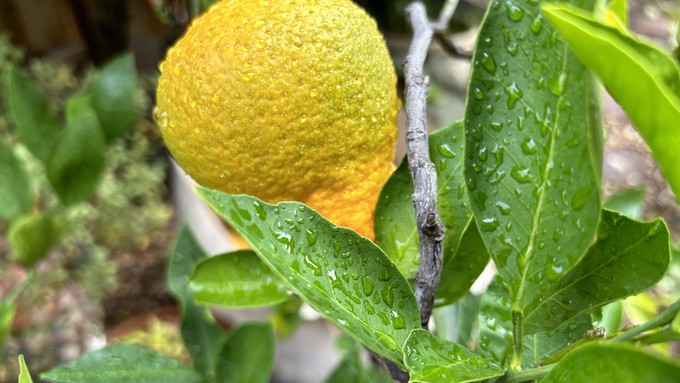
Clear and cool conditions expected after Saturday's soaking

The ripening mandarins and the rest of the garden were getting a good soaking Saturday, but the weather is expected to be drier during Thanksgiving week. Kathy Morrison
Don’t worry; our Thanksgiving Day shouldn’t be soggy.
Saturday’s stormy start to our weekend will blow over quickly, says the National Weather Service. Strong, gusty winds will push out those thunder clouds by late Saturday night. But Monday, we’ll settle into a cool and calm pattern typical of mid to late November.
This looks like a good week to spray your peach trees. (Ideally, do it at least twice during the fall/winter: around Thanksgiving -- assuming the tree has dropped its leaves -- and again at bud swell just before the buds begin to open. That is usually around Valentine's Day, although can be early in warmer. drier winters.)
According to the weather service, Sacramento can expect about a half inch of rain from Saturday’s storm. That’s enough to turn off your irrigation system until at least the end of the week. Check your soil moisture, particularly in sheltered locations such as under eaves or large evergreen trees where rain didn’t reach.
Temperature-wise, Sacramento will be just about normal for November. Highs this week will hover in the mid 60s. Overnight lows will dip into the low 40s. Average for this month in Sacramento: High of 64 and low of 43.
No rain is in Thursday’s forecast – good news for Thanksgiving travel plans. The weather service says expect sun, a slight breeze and a high of 65.
Make the most of this week’s calm fall weather and damp soil. Get out and garden! (It’s a great way to burn calories after a big meal.)
* The weather conditions later this week look ideal for spraying dormant fruit trees. For sprays to be effective, they need at least 24 hours to dry.
* To help prevent leaf curl, apply a copper fungicide spray to peach and nectarine trees after they lose their leaves. Leaf curl, which shows up in the spring, is caused by a fungus that winters as spores on the limbs and around the tree in fallen leaves. Sprays are most effective when applied in late fall.
* Rake and compost leaves, but dispose of any diseased plant material (such as peach leaves infected with leaf curl).
* Give your azaleas, gardenias and camellias a boost with chelated iron.
* After they bloom, chrysanthemums should be trimmed to 6 to 8 inches above the ground. If in pots, keep the mums in their containers until next spring. Then, they can be planted in the ground, if desired, or repotted.
* Save dry stalks and seedpods from poppies and coneflowers for fall bouquets and holiday decorating.
* Prune non-flowering trees and shrubs while dormant.
* Plant more bulbs to spread out your spring bloom. Some possible suggestions: daffodils, crocuses, hyacinths, tulips, anemones and scillas.
* Seed California poppies and other wildflowers.
* Plant sweet peas, sweet alyssum, bachelor buttons and other spring-blooming annuals.
* Now is the best time to plant most trees and shrubs. This gives them plenty of time for root development before spring growth. They also benefit from fall and winter rains.
* Set out cool-weather annuals such as pansies and snapdragons.
* Lettuce, cabbage and broccoli also can be planted now.
* Plant garlic and onions.
Comments
0 comments have been posted.Sacramento Digs Gardening to your inbox.
Sites We Like
Garden Checklist for week of April 21
This week there’s plenty to keep gardeners busy. With no rain in the immediate forecast, remember to irrigate any new transplants.
* Weed, weed, weed! Get them before they flower and go to seed.
* April is the last chance to plant citrus trees such as dwarf orange, lemon and kumquat. These trees also look good in landscaping and provide fresh fruit in winter.
* Smell orange blossoms? Feed citrus trees with a low dose of balanced fertilizer (such as 10-10-10) during bloom to help set fruit. Keep an eye out for ants.
* Apply slow-release fertilizer to the lawn.
* Thoroughly clean debris from the bottom of outdoor ponds or fountains.
* Spring brings a flush of rapid growth, and that means your garden is really hungry. Feed shrubs and trees with a slow-release fertilizer. Or mulch with a 1-inch layer of compost.
* Azaleas and camellias looking a little yellow? If leaves are turning yellow between the veins, give them a boost with chelated iron.
* Trim dead flowers but not leaves from spring-flowering bulbs such as daffodils and tulips. Those leaves gather energy to create next year's flowers. Also, give the bulbs a fertilizer boost after bloom.
* Pinch chrysanthemums back to 12 inches for fall flowers. Cut old stems to the ground.
* Mulch around plants to conserve moisture and control weeds.
* From seed, plant beans, beets, cantaloupes, carrots, corn, cucumbers, melons, radishes and squash.
* Plant onion sets.
* In the flower garden, plant seeds for asters, cosmos, celosia, marigolds, salvia, sunflowers and zinnias.
* Transplant petunias, zinnias, geraniums and other summer bloomers.
* Plant perennials and dahlia tubers for summer bloom.
* Mid to late April is about the last chance to plant summer bulbs, such as gladiolus and tuberous begonias.
* Transplant lettuce seedlings. Choose varieties that mature quickly such as loose leaf.